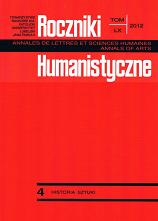Polskie kadzielnice z XVII w. o tradycjach romańskich i gotyckich
Polish modern censers of the 17th century with Romanesque and Gothic traditions
Author(s): Małgorzata Kierczuk-MacieszkoSubject(s): History of Church(es)
Published by: Towarzystwo Naukowe KUL & Katolicki Uniwersytet Lubelski Jana Pawła II
Keywords: censer; goldsmithery; the seventeenth century
Summary/Abstract: Censers (Latin: tribulum) are a group of antique objects that has not been yet researched well enough. The article discusses eleven modern specimens from the first half of the 17th century, in whose shape or decoration references can be seen to the forms from the medieval period. Several factors are the cause why so few censers from that time have been preserved in Poland: in the Catholic Church they were not as highly valued as vasa sacra that were used for the Eucharist itself; they decayed rapidly due to mechanical damage or contact with a high temperature; and finally they were good investment: they were melted, sold, stolen etc. The specimens in Mrzygłód, Jarogniewice and Poznań are patterned after the spherical Roman vessels from before about 1150. Their main body constitutes a support for a tower finial, with its considerable height diverging from the medieval models. About 1150 „architectonic” censers gained popularity that looked like faithful models of the Heavenly Jerusalem. The model was still used in the Gothic period, albeit it was reduced to the shape of the church. The idea that was born in the Middle Ages ordering formation of the censer on the pattern of the church lasted in the Polish goldsmithery until the middle of the 17th century, which is proven by seven vessels in the discussed group. Their finials, or the entire covers, look like spires (Zielonki, Małogoszcz, Żmigród Nowy, the Diocesan Museum in Przemyśl), or segmented cupolas with a lantern (Słupia, Licheń Stary, Graboszewo). The construction is complemented with a mixture of Gothic and modern ornaments. The censer cover from Służewo that looks like a tempietto, is the last link in the chain of the development of the architectonic mass of censers that evaluated according to the style of the changing epochs. The reason why conservative forms were used in goldsmithery for so long was the conservatism of the public. And what is more, these forms are typical of the vessels that were used for the worship of the Eucharist and relics that was denied by the Reformation. Their ideological archaism had a propaganda meaning then, proving the constancy and the many centuries of tradition of the institution of the Catholic Church. Who were the donors of the censers and why did they found them? Founded as votive offerings or as an expression of one's private cult they manifested the prestige of the donor, irrespective of his being a clergyman or a lay person. For this reason inscriptions were engraved with his personal details, or more rarely with his initials or coat of arms only, so that they served commemorating the donor. The fact of offering the vessel to God made the person's „chances” to be saved greater. Every time the altar was incensed the dead donor participated symbolically in the rite, and the prayer of the faithful indirectly became a prayer for him.
Journal: Roczniki Humanistyczne
- Issue Year: 60/2012
- Issue No: 04
- Page Range: 147-175
- Page Count: 29
- Language: Polish

